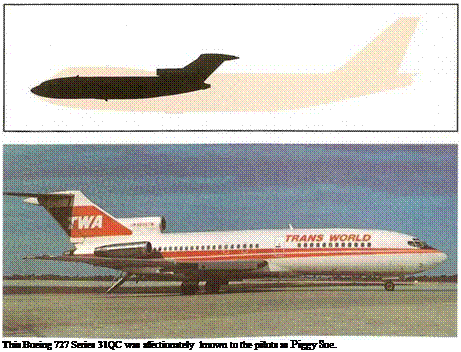Boeing 727-31
|
|
Engines |
Pratt & Whitney JT8D (14,000 lb) x 3 |
Length |
133 feet |
|
MGT0W |
152,500-164,500 lb |
Span |
108 feet |
|
Range |
1,700 miles |
Height |
34 feet |
Short and Medium Haul
Once again, to follow the example of the Caravelle, the initiative had been taken overseas, when de Havilland supplemented its Comet production by launching the world’s first tri-jet, the D. H.121 Trident. Like the Caravelle, all three engines were in the rear, two on the sides of the fuselage, and one faired into the base of the vertical stabilizer. It first flew on 9 January 1962. But the British missed their chance by some incredible bungling. Under pressure from British European Airways, the 100-seat Trident design was irrevocably compromised by reducing the size to 86—not much bigger than the Caravelle. The first Trident had been sized just right for both the European and the U. S. markets. Not only that, de Havilland allowed a Boeing team to inspect it.
Three weeks later, the Seattle team announced the 100-seat Boeing 727, remarkably similar in design to the Trident. The 727 made its first flight on 9 February 1963, and more than 1,800 left the Seattle factory. It first went into service with Eastern Air Lines on 1 February 1963. T. W.A. ordered ten Boeing 727s in March 1962, and it was to become one of the most versatile airliners ever produced. T. W.A.’s entered service on 1 June 1964.
 Shortly thereafter, on 20 July, T. W.A. ordered 20 twin-jet, rear-engined Douglas DC-9s, once again taking the home-built product in preference to the British Aircraft Corporation’s BACOne-EIeven, This was the first second-generation rear-engined twin-jet to follow the Caravelle, and it had already made inroads into the American market. But T. W.A. chose the DC-9 and started service on 17 March 1966 (see page 77).
Shortly thereafter, on 20 July, T. W.A. ordered 20 twin-jet, rear-engined Douglas DC-9s, once again taking the home-built product in preference to the British Aircraft Corporation’s BACOne-EIeven, This was the first second-generation rear-engined twin-jet to follow the Caravelle, and it had already made inroads into the American market. But T. W.A. chose the DC-9 and started service on 17 March 1966 (see page 77).











